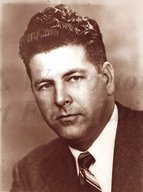
|

|
|
|
|
Thomas was born in Shreveport in a shotgun house in the 1200 block of Jordan Street to Thomas Murray Landrum and Virginia Lay Landrum. His father was a painter and a paperhanger, who moved the family to the Queensborough neighborhood where Thomas lived until he married. The house had electricity but no city sewer or water. With no family car, his father walked to work, or took streetcars or found a ride. Thomas helped supplement the family income. He unloaded stone from railroad cars for the building of the Louisiana State Exhibit Building, of which his uncle was contractor. Graduating from Fair Park High School in 1938, he worked as a roofer, a forklift operator, and service station manager. Thomas was drafted in 1942, he believes on April 1. He trained at Camps Beauregard and Claiborne. He recalls his rifle training as minimal. At Camp Claiborne, he fired five rounds on the rifle range with a Springfield rifle. Sent to Fort Dix, New Jersey, he was assigned to the 342nd Engineer General Service Regiment, a general service regiment. At Fort Dix he was issued an M1 carbine, and fired one clip. He shipped out to Europe on an English vessel, HMS Duchess of Bedford, on July 1, 1942. Thomas, by then a corporal, landed at Leeds, and then was sent to a British camp, where he was in charge of a group of men building barracks and a quartermaster depot. He was hospitalized for a hernia operation and a tonsillectomy, and was later shipped to another British camp in Ripon, Yorkshire. Rations were slim at the British camp, he say, and mainly included lamb, Brussels sprouts, potatoes, beans, and hot tea. "I've had occasion to count my beans that I got for my serving--thirty-two beans for breakfast," he says. As part of the 1172nd Engineer Combat Headquarters he worked in a bridge-building school, which trained combat engineer companies. Thomas entered France at Omaha Beach "about three months" after D-Day. He continued to work in the bridge-building school, while noting that many French houses were flying American flags. When the Germans broke through in the Battle of the Bulge, however, he says the American flags disappeared. After the war he came home on the David C. Shanks, a Liberty ship, and was discharged in October of 1945, at Camp Shelby near Hattiesburg, Mississippi. Divorced during the war, Thomas wed Virginia Matthews in December of 1946, to whom he was married fifty-four years. She died in 1999 and he married Wanda Bryant. Thomas worked at several endeavors, including selling and delivering dynamite to seismograph crews in the oil fields for Southern Sales and Transportation Company. He later worked for Schlumberger Oil Services from 1947 to 1967. He was employed at Louisiana Ordinance Plant, sold tires for Sears, and worked in manufacturing for Byrd Roofing. Throughout much of his post-service life Thomas has remained an avid golfer. |


